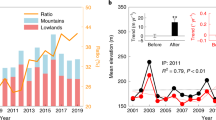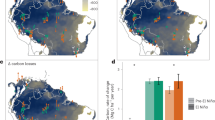Abstract
Large-scale, abrupt ecosystem change in direct response to climate extremes is a critical but poorly documented phenomenon1. Yet, recent increases in climate-induced tree mortality raise concern that some forest ecosystems are on the brink of collapse across wide environmental gradients2,3. Here we assessed climatic and productivity trends across the world’s five Mediterranean forest ecosystems from 2000 to 2021 and detected a large-scale, abrupt forest browning and productivity decline in Chile (>90% of the forest in <100 days), responding to a sustained, acute drought. The extreme dry and warm conditions in Chile, unprecedented in the recent history of all Mediterranean-type ecosystems, are akin to those projected to arise in the second half of the century4. Long-term recovery of this forest is uncertain given an ongoing decline in regional water balance. This dramatic plummet of forest productivity may be a spyglass to the future for other Mediterranean ecosystems.
This is a preview of subscription content, access via your institution
Access options
Access Nature and 54 other Nature Portfolio journals
Get Nature+, our best-value online-access subscription
$29.99 / 30 days
cancel any time
Subscribe to this journal
Receive 12 digital issues and online access to articles
$119.00 per year
only $9.92 per issue
Buy this article
- Purchase on Springer Link
- Instant access to full article PDF
Prices may be subject to local taxes which are calculated during checkout



Similar content being viewed by others
Data availability
All data are available in the article. Source data are provided with this paper.
Code availability
The codes generated during the current study are available from the corresponding author on reasonable request.
References
Godfree, R. C. et al. Historical reconstruction unveils the risk of mass mortality and ecosystem collapse during pancontinental megadrought. Proc. Natl Acad. Sci. USA 116, 15580–15589 (2019).
Allen, C. D., Breshears, D. D. & McDowell, N. G. On underestimation of global vulnerability to tree mortality and forest die-off from hotter drought in the Anthropocene. Ecosphere 6, 129 (2015).
Allen, C. D. et al. A global overview of drought and heat-induced tree mortality reveals emerging climate change risks for forests. For. Ecol. Manage. 259, 660–684 (2010).
Bozkurt, D., Rojas, M., Boisier, J. P. & Valdivieso, J. Projected hydroclimate changes over Andean basins in central Chile from downscaled CMIP5 models under the low and high emission scenarios. Climatic Change 150, 131–147 (2018).
Bergstrom, D. M. et al. Combating ecosystem collapse from the tropics to the Antarctic. Glob. Change Biol. 27, 1692–1703 (2021).
Bland, L. M. et al. Developing a standardized definition of ecosystem collapse for risk assessment. Front. Ecol. Environ. 16, 29–36 (2018).
Newton, A. C. et al. Operationalising the concept of ecosystem collapse for conservation practice. Biol. Conserv. 264, 109366 (2021).
Newton, A. C. Ecosystem Collapse and Recovery (Cambridge Univ. Press, 2021).
Berdugo, M. et al. Global ecosystem thresholds driven by aridity. Science 367, 787–790 (2020).
Rundel, P. W. et al. Mediterranean biomes: evolution of their vegetation, floras, and climate. Annu. Rev. Ecol. Evol. Syst. 47, 383–407 (2016).
Anderegg, W. R. L., Anderegg, L. D. L., Kerr, K. L. & Trugman, A. T. Widespread drought-induced tree mortality at dry range edges indicates that climate stress exceeds species’ compensating mechanisms. Glob. Change Biol. 25, 3793–3802 (2019).
Adams, H. D. et al. A multi-species synthesis of physiological mechanisms in drought-induced tree mortality. Nat. Ecol. Evol. 1, 1285–1291 (2017).
Choat, B. et al. Triggers of tree mortality under drought. Nature 558, 531–539 (2018).
Das, A. J. et al. Empirically validated drought-vulnerability mapping in the mixed conifer forests of the Sierra Nevada. Ecol. Appl. 32, e2514 (2022).
Pettorelli, N. et al. Using the satellite-derived NDVI to assess ecological responses to environmental change. Trends Ecol. Evol. 20, 503–510 (2005).
Garreaud, R. D. et al. The Central Chile mega drought (2010–2018): a climate dynamics perspective. Int. J. Climatol. 40, 421–439 (2019).
Chen, D. et al. in Climate Change 2021: The Physical Science Basis (eds Masson-Delmotte, V. et al) 147–286 (Cambridge Univ. Press, 2021).
Garreaud, R. D., Clem, K. & Veloso, J. V. The South Pacific pressure trend dipole and the southern blob. J. Clim. 34, 7661–7676 (2021).
Arroyo, M. T. K. et al. Extreme drought affects visitation and seed set in a plant species in the Central Chilean Andes heavily dependent on hummingbird pollination. Plants 9, 1553 (2020).
Fettig, C. J., Mortenson, L. A., Bulaon, B. M. & Foulk, P. B. Tree mortality following drought in the central and southern Sierra Nevada, California, U.S. For. Ecol. Manage. 432, 164–178 (2019).
Senf, C., Buras, A., Zang, C. S., Rammig, A. & Seidl, R. Excess forest mortality is consistently linked to drought across Europe. Nat. Commun. 11, 6200 (2020).
Matusick, G., Ruthrof, K. X., Brouwers, N. C., Dell, B. & Hardy, G. S. J. Sudden forest canopy collapse corresponding with extreme drought and heat in a Mediterranean-type eucalypt forest in southwestern Australia. Eur. J. Res. 132, 497–510 (2013).
Andivia, E. et al. Climate and species stress resistance modulate the higher survival of large seedlings in forest restorations worldwide. Ecol. Appl. 31, e02394 (2021).
Schenk, H. J. et al. Hydraulic integration and shrub-growth form linked across continental aridity gradients. Proc. Natl Acad. Sci. USA 105, 11248–11253 (2008).
Nolan, R. H. et al. Limits to post‐fire vegetation recovery under climate change. Plant Cell Environ. 44, 3471–3489 (2021).
Holmgren, M. Exotic herbivores as drivers of plant invasion and switch to ecosystem alternative states. Biol. Invasions 4, 25–33 (2002).
Chávez, R. O. et al. A probabilistic multi-source remote sensing approach to evaluate extreme precursory drought conditions of a wildfire event in Central Chile. Front. Environ. Sci. 10, 865406 (2022).
Smith-Ramírez, C. et al. Recovery of Chilean Mediterranean vegetation after different frequencies of fires. For. Ecol. Manage. 485, 118922 (2021).
Venegas-González, A. et al. Sclerophyllous forest tree growth under the influence of a historic mega-drought in the Mediterranean Ecoregion of Chile. Ecosystems 26, 344–361 (2023).
Seidl, R. et al. Forest disturbances under climate change. Nat. Clim. Change 7, 395–402 (2017).
Saatchi, S. et al. Persistent effects of a severe drought on Amazonian forest canopy. Proc. Natl Acad. Sci. USA 110, 565–570 (2013).
Dudney, J. & Suding, K. N. The elusive search for tipping points. Nat. Ecol. Evol. 4, 1449–1450 (2020).
Hillebrand, H. et al. Thresholds for ecological responses to global change do not emerge from empirical data. Nat. Ecol. Evol. 4, 1502–1509 (2020).
Dinerstein, E. et al. An ecoregion-based approach to protecting half the terrestrial realm. BioScience 67, 534–545 (2017).
Ackerly, D. D., Stock, W. D. & Slingsby, J. A. in Fynbos (eds Allsopp, N. et al.) 361–376 (Oxford Univ. Press, 2014).
Beck, H. E. et al. Present and future Köppen–Geiger climate classification maps at 1 km resolution. Sci. Data 5, 180214 (2018).
Trabucco, A. & Zomer, R. Global aridity index and potential evapotranspiration (ET0) climate database v.2. figshare https://doi.org/10.6084/m9.figshare.7504448.v3 (2019).
Adler, R. F. et al. The Version-2 Global Precipitation Climatology Project (GPCP) monthly precipitation analysis (1979–Present). J. Hydrometeorol. 4, 1147–1167 (2003).
Harris, I., Osborn, T. J., Jones, P. & Lister, D. Version 4 of the CRU TS monthly high-resolution gridded multivariate climate dataset. Sci. Data 7, 109 (2020).
Taylor, K. E., Stouffer, R. J. & Meehl, G. A. An overview of CMIP5 and the experiment design. Bull. Am. Meteorol. Soc. 93, 485–498 (2012).
Gorelick, N. et al. Google Earth Engine: planetary-scale geospatial analysis for everyone. Remote Sens. Environ. 202, 18–27 (2017).
Friedl, M. & Sulla-Menashe, D. MCD12Q1 MODIS/Terra+Aqua Land Cover Type Yearly L3 Global 500m SIN Grid V006. EarthData https://doi.org/10.5067/MODIS/MCD12Q1.006 (2019).
Giglio, L., Justice, C., Boschetti, L. & Roy, D. MCD64A1 MODIS/Terra+Aqua Burned Area Monthly L3 Global 500m SIN Grid V006. EarthData https://doi.org/10.5067/MODIS/MCD64A1.006 (2015).
Zhao, Y. et al. Detailed dynamic land cover mapping of Chile: accuracy improvement by integrating multi-temporal data. Remote Sens. Environ. 183, 170–185 (2016).
Miranda, A. et al. Forest browning trends in response to drought in a highly threatened Mediterranean landscape of South America. Ecol. Indic. 115, 106401 (2020).
Hansen, M. C. et al. High-resolution global maps of 21st-century forest cover change. Science 342, 850–853 (2013).
Fong, Y., Huang, Y., Gilbert, P. B. & Permar, S. R. chngpt: threshold regression model estimation and inference. BMC Bioinformatics 18, 454 (2017).
Acknowledgements
A.M., S.G, A.L. and R.G. thank ANID/FONDAP/15110009, and A.M. thanks ANID Postdoctoral Fondecyt project 3210101. F.S. thanks ANID grants FB210006 and ACE210006 to the Institute of Ecology and Biodiversity (IEB). A.M. and J.C. acknowledges the support of the European Union’s Horizon 2020 research and innovation programme under grant agreement no. 101037419, and J.C. acknowledges Postdoctoral Fondecyt project 3210311. S.G. thanks FORPES project PID2019-106908RA-I00/AEI/10.13039/501100011033 from MICINN, Spain. J.F.O. was supported by the Chilean Foundation of Science and Technology (FONDECYT) Grant 11191147. We also thank the Center of Applied Ecology and Sustainability (CAPES) project PIA/BASAL FB0002. S.V. thanks ANID no. 9219/2022 Concurso Subvención a la Instalación en la Academia, Code 85220080.
Author information
Authors and Affiliations
Contributions
A.M., R.G., A.D.S., M.B., A.L. and S.G.-G. conceptualized the project. A.M., R.G. and J.C. developed the methodology. A.M., R.G., R.M., J.C. and M.D.M. curated data. A.M., R.G., R.M., J.C. and M.D.M. conducted formal analysis. A.M., R.G., R.M. and M.D.M. performed visualization. A.M., R.G., F.A.S., M.D.M., J.F.O., C.A.D. and A.L. acquired funding. A.M., J.F.O., C.A.D. and S.V. administered the project. A.M., R.G., A.D.S., M.B., M.D.M., S.G. and A.L. wrote the original draft, which was reviewed and edited by A.M., R.G., J.F.O., A.D.S., M.B., F.A.S., C.A.D., S.V., M.D.M., C.D., S.G. and A.L.
Corresponding author
Ethics declarations
Competing interests
The authors declare no competing interests.
Peer review
Peer review information
Nature Plants thanks Víctor Resco de Dios and the other, anonymous, reviewer(s) for their contribution to the peer review of this work.
Additional information
Publisher’s note Springer Nature remains neutral with regard to jurisdictional claims in published maps and institutional affiliations.
Supplementary information
Supplementary Information
Supplementary Methods, Figs.1–4 and Tables 1–3.
Source data
Source Data Fig. 1
Annual regional mean NDVI for all MTEs.
Source Data Fig. 2
The 1901–2020 annual precipitation anomalies for all MTEs. The 1901–2020 11-year mean-precipitation anomalies for all MTEs. The 1901–2020 11-year mean-maximum temperature anomalies for all MTEs.
Rights and permissions
Springer Nature or its licensor (e.g. a society or other partner) holds exclusive rights to this article under a publishing agreement with the author(s) or other rightsholder(s); author self-archiving of the accepted manuscript version of this article is solely governed by the terms of such publishing agreement and applicable law.
About this article
Cite this article
Miranda, A., Syphard, A.D., Berdugo, M. et al. Widespread synchronous decline of Mediterranean-type forest driven by accelerated aridity. Nat. Plants 9, 1810–1817 (2023). https://doi.org/10.1038/s41477-023-01541-7
Received:
Accepted:
Published:
Issue Date:
DOI: https://doi.org/10.1038/s41477-023-01541-7



